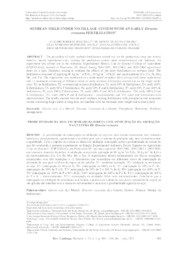Soybean yield under no-tillage system with an early eleusine coracana fertilization.
Soybean yield under no-tillage system with an early eleusine coracana fertilization.
Autoria: SEGATELLI, C. R.; CÂMARA, G. M. de S.; AGUILA, L. S. H. D.; JUAN SAAVEDRA DEL AGUILA; FRANCISCO, E. A. B.; PIEDADE, S. M. de S.
Resumo: The possibility of early soybean fertilization carried out on the predecessor crop has several benefits, mainly operational ones, making the production system more conservationist and balanced. An experiment was carried out at the Anhumas Experimental Station, Luiz de Queiroz College of Agriculture (USP/ESALQ), located in Piracicaba, SP, Brazil, during 2001/2002, 2002/2003, and 2003/2004 agricultural years on a typic Hapludox aiming to evaluate the effects of the early fertilization on soybean yield. The fertilization consisted of applying 90 kg ha?1 of P2O5, 50 kg ha?1 of K2O, and micronutrients (Co, Cu, Fe, Mn, Mo, and Zn). The experiment was conducted in a randomized complete block design with three replications and 12 treatments consisting of different levels of early soybean fertilization carried out on the finger millet crop: T1, no fertilization; T2, conventional soybean fertilization; T3, early 50% K fertilization; T4, early 100% K fertilization; T5, early 50% P fertilization; T6, early 50% P and K fertilization; T7, early 50% P and 100% K fertilization; T8, early 100% P fertilization; T9, early 100% P and 50% K fertilization; T10, early 100% P and K fertilization; T11, early 100% P and K fertilization + micronutrients; and T12, early leaf fertilization with micronutrients. The results showed that the early soybean sowing fertilization with phosphorus and potassium carried out during finger millet sowing does not interfere with the thousand-seed weight and soybean yield.
Ano de publicação: 2022
Tipo de publicação: Artigo de periódico
Unidade: Embrapa Clima Temperado
Palavras-chave: Adubação, Fertilidade, Fósforo, Glycine Max, Manejo, Potássio, Soja
Observações
1 - Por padrão são exibidas publicações dos últimos 20 anos. Para encontrar publicações mais antigas, configure o filtro ano de publicação, colocando o ano a partir do qual você deseja encontrar publicações. O filtro está na coluna da esquerda na busca acima.
2 - Para ler algumas publicações da Embrapa (apenas as que estão em formato ePub), é necessário ter, no celular ou computador, um desses softwares gratuitos. Sistemas Android: Google Play Livros; IOS: iBooks; Windows e Linux: software Calibre.
Acesse outras publicações
Acesse a Base de Dados da Pesquisa Agropecuária (BDPA) para consultar o acervo completo das bibliotecas da Embrapa.

